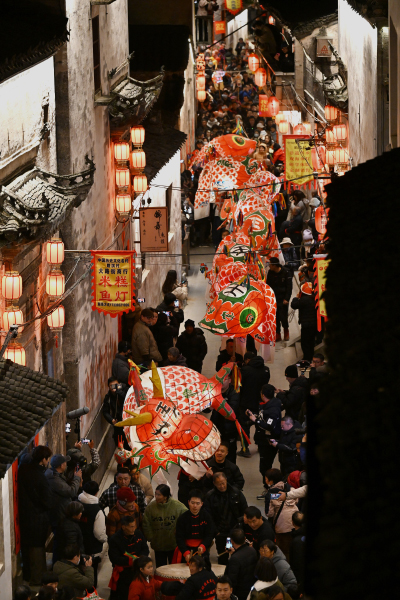
In a very diversified global community, culture has acted as a powerful binding force that keeps the world from falling apart. And China, with a rich tapestry of culture that continues to absorb, adapt and evolve, has been a major player in facilitating global cultural exchange and fostering human connection at a deeper level.
In recent months, Shanghai appears to have become the new darling of young adults from the Republic of Korea (ROK), an increasing number of whom are flocking to China for short weekend getaways. According to data from Chinese online travel agency Trip.com, bookings by people from the ROK for travel during the Chinese New Year holiday, from January 28 to February 4, has seen a year-on-year increase of 452 percent.
This drastic surge in ROK travelers is part of a broader trend, as China swings its doors increasingly wide to open up itself up to international visitors.
#ChinaTravel
Starting on December 1, 2023, visitors from France, Germany, Italy, the Netherlands, Spain and Malaysia were allowed to enter China visa-free for up to 15 days for business, tourism, family visits or transit purposes. By November 30, 2024, the list had been expanded several times to allow 38 countries, including the ROK, unilateral visa-free access to China, and the maximum stay for visitors had also been extended to 30 days.
From December 17 onward, China had also extended its 144-hour and 72-hour visa-free transit policy to 240 hours for citizens of 54 countries.
On top of these visa-free policies, China was also committed to improving the digital payment experience for visitors. In 2024, Alipay and WeChat Pay, the country’s two largest e-wallet service providers, both introduced new policies such as simplified verification and raised limits on single transactions.
These measures together led to a massive influx of international visitors. According to data released by the National Immigration Administration, more than 20 million foreign nationals entered the country visa-free in 2024, up 112.3 percent year on year.
The astounding numbers aside, the surge in inbound tourism also made “China Travel” a trending hashtag on some of the world’s largest social networks, including YouTube, TikTok and Instagram, where countless influencers posted vlogs of their 144-hour sojourn in the country. From showcasing how technologies seamlessly blend into daily life to exploring smaller, less-known cities and towns across the country, these videos presented to the world a country drastically different from the China portrayed in mainstream Western media.
Meanwhile, the catchphrase, “city bu city,” or “city or not city,” took Chinese social media by storm last summer. Popularized by Shanghai-based American influencer Paul Mike Ashton, known online as Bao Bao Xiong, who uses “city” as a substitute for “cool” or “trendy,” the expression was a perfect manifestation of how social media, coupled with a rebound in international visitors, can bring about fresh perspectives on the many modern aspects of contemporary China.
Honoring the past
Another keyword that stood out last year within the shifting lexicon of inter-civilizational dialogue was the preservation of cultural heritage.
At the 46th Session of the World Heritage Committee held in India in July 2024, the Beijing Central Axis was added to UNESCO’s World Heritage List. Running north to south through the heart of the historical city, the Central Axis is a cluster of imperial palace buildings and gardens, ceremonial and public buildings and remains of ancient roads, which, coming from different eras, all bear testimony to the evolution of Beijing.
Its recent inscription on the list of world heritage sites underscores China’s lasting commitment to the conservation of relics. Over the past few years, more than 100 cultural heritage restoration projects have been initiated along the axis, and efforts have also been made to renovate and upgrade residential neighborhoods nearby.
A slew of digital programs have also been launched to offer tourists from home and abroad a more dynamic experience of the many architectural marvels on the Central Axis. These programs include a digital light show staged in the Bell Tower; Time Capsule, an online project where users can embark on a virtual tour of the axis; and Microcosm, a 3D virtual replica of the heritage site created by Chinese tech giant Tencent using gaming technology.
Last December, Spring Festival, social practices of the Chinese people in celebration of traditional new year was also added to UNESCO’s Representative List of the Intangible Cultural Heritage of Humanity. With this latest addition, China now has 44 cultural elements or practices included in the list, more than any other country or region in the world.
The 2024 Spring Festival was also the first since the United Nations passed a resolution to include the Chinese New Year in its list of official holidays. As of now, some 20 countries have recognized the event as a public holiday.
A universal occasion for the celebration of life, culture and community, the festival saw people around the world ring in the Year of the Dragon on February 10, with a myriad of parades, performances, exhibitions, temple fairs and workshops aimed at sharing Chinese customs and traditions.
This phenomenon not only reflected the growing global appeal of traditional Chinese culture but also demonstrated how the many values the festival carries, such as peace, harmony and the importance of family, can connect all of humanity.

Breaking new ground
While the Beijing Central Axis, the Spring Festival and many other aspects of traditional Chinese culture are gaining recognition and popularity worldwide, other homegrown forces representing the future also reshaped the fabric of global digital entertainment.
Perhaps one of the country’s biggest cultural moments of 2024 was the release of Black Myth: Wukong, a video game created by the Chinese studio Game Science. As China’s first big-budget, AAA video game, it was an immediate global hit, drawing in over 2.2 million concurrent players worldwide on digital distribution platform Steam on August 20, the day of its release. In the month that followed, the game sold more than 20 million copies, which made it one of the year’s top-selling games.
Based on the iconic 16th-century Chinese novel Journey to the West, the game embeds a wealth of Chinese cultural elements in its richly detailed settings. It not only draws inspiration from a vast array of ancient Chinese architecture but also features a wide assortment of gods and goblins that can be traced back to Chinese folklore.
In December 2024, the game received the Best Action Game and Players’ Voice awards at the Games Awards, an annual event held in Los Angeles, the U.S., which is often referred to as the Oscars of the gaming world. It also became the first Chinese video game to be nominated for Game of the Year, the event’s biggest prize.
With its high-profile release and widespread popularity, the game may prove a turning point, one that paves the way for more Chinese games to blend traditional Chinese culture with world-class game development.
Chinese web literature also embraced a landmark moment in 2024. In November, 10 popular Chinese web novels including Lord of the Mysteries, Soul Land, and The Joy of Life were added to the British Library’s collection as part of a three-year partnership between the library and Yuewen, a Chinese online literature platform, to further promote Chinese online novels to a global audience.
Besides video games and web novels, micro-dramas, a new vertical video format characterized by ultra-short and extremely fast-paced storytelling, have emerged as a potent force in global entertainment.
For the first time since its rise around 2010, the micro-series genre outpaced the traditional film industry’s annual box office revenue in China with a market size valued at 50 billion yuan ($6.8 billion), a report by online platform Tencent News found.
According to U.S. data analysis company Sensor Tower, more than 40 Chinese short drama apps had made their way into the global market by early 2024, generating some 55 million downloads and $170 million in in-app purchases.
While these digital sectors are still in their early phase of worldwide expansion, together they embody a new approach to how the country can carve out a place in the global entertainment market with distinctly Chinese narratives and aesthetics. –The Daily Mail-Beijing Review news exchange item





